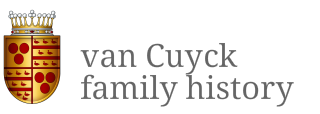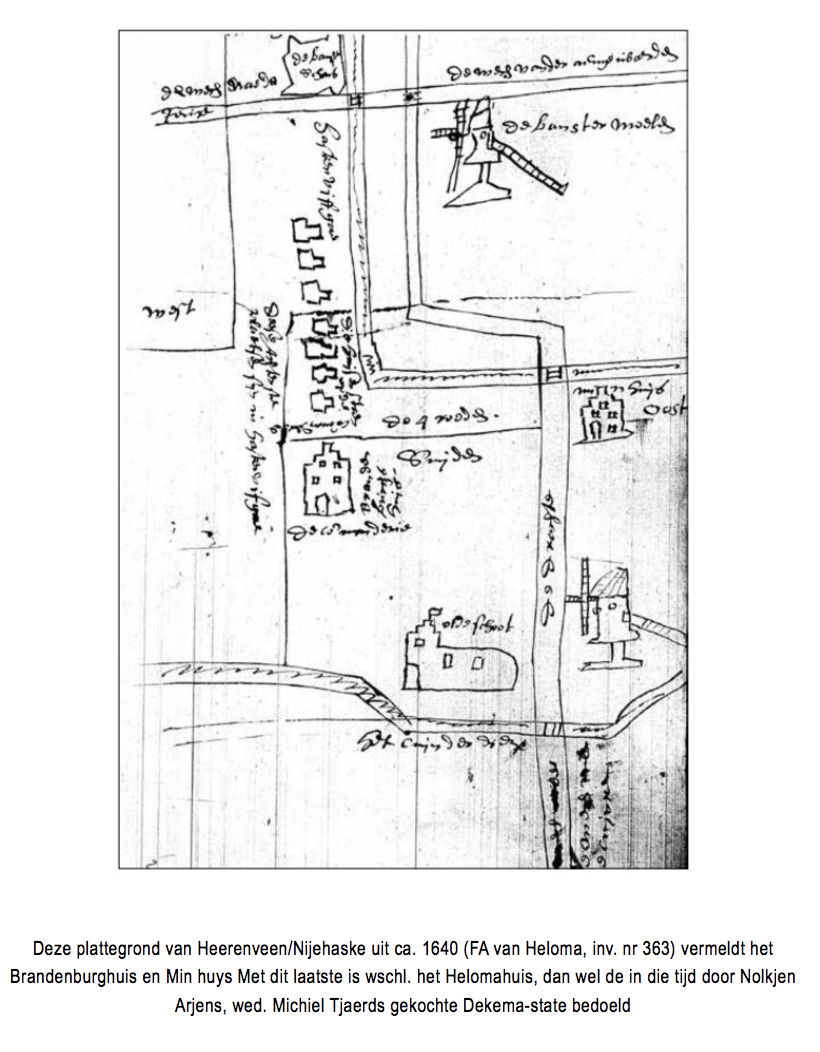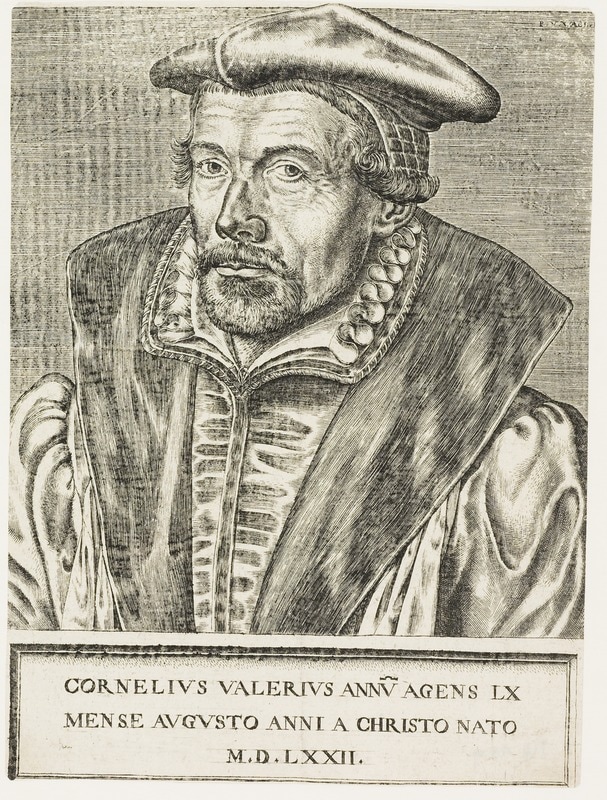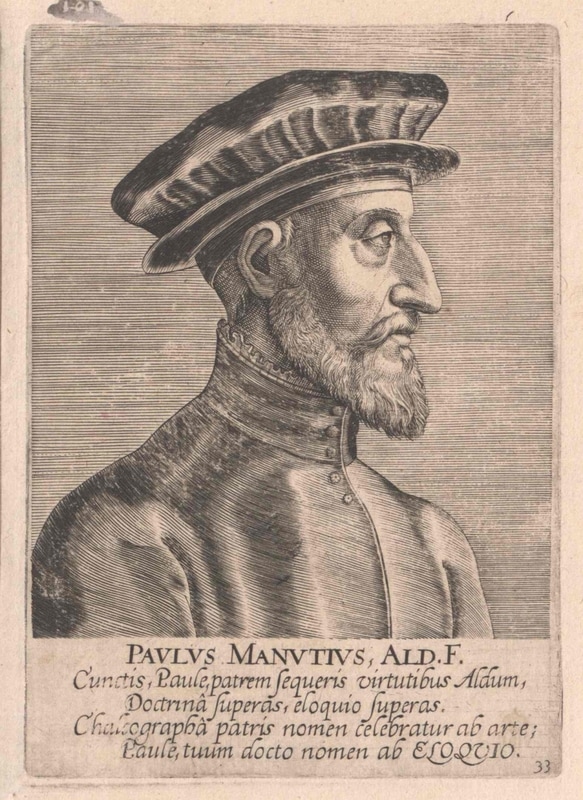The van Cuyck family in Heerenveen
|
Jan Anthonisz. van Cuyck (1509 – 1566)
Jan Anthonisz. Van Cuyck was born in Utrecht on 31 October 1509. He was the son of Anthonis van Cuyck and Gauborch Pijll. Jan studied law. From 1534 to 1543 he was raed / raid and alderman of Utrecht. In 1541 he was in the Cleyne Calander in Utrecht. Jan van Cuyck was mayor of Utrecht in 1544/45 and 1545/46, together with Adam Ram. He founded the Decama-, Cuyck- and Foeyts-veencompagnie in 1551 (*). Jan married Elisabeth van Moerendael (before 1515 – 1576) in 1533. She was a daughter of Hendrik Wilgersz and Alit Thymansdr. Knijff. They had 9 children:
Jan Anthonisz. Van Cuyck was a respected scholar. He not only annotated Flavius Charisius and Audonius, but he also published several works himself (***):
He died on 17 November/December 1566. His widow died on 25 April 1576. Bibliography and sources
Tyman Jansz. van Cuyck (1540 – 1616) Tyman Jansz. van Cuyck was born in Utrecht on 5 October 1540. He was the son of Jan van Cuyck and Elisabeth van Moerendael. Tyman was married to Catharina van Sompijken (Cathalina van Sombeecken, van Zombeecke), daughter of Augustijn. They had several children:
He lived in Utrecht: "Residerende binnen de stad Utrecht" (18.09.1587 - TRESOAR, 103 Decama-, Cuyck- en Foeyts Veencompagnie, inv. 307); "wonende te Utrecht" (4.11.1592 - TRESOAR, 103 Decama-, Cuyck- en Foeyts Veencompagnie, inv. 328). He died on 30 october 1616 and was buried in the church of Oldschote (TRESOAR, 319 Familie Van Beyma thoe Kingma, inv. 629). Sources and bibliography
(*) HEERENVEEN AND DEKEMA, CUYCK AND FOEYT’S COMPANY Frisian peat moors, mainly located in the north of Friesland, were first exploited in the early thirteenth century. These early exploitations were mainly carried out by cloisters and noble families. It was at that time the latter laid the foundations of the companies that would rule the peat industry in the years to come. The Van Dekema family, based in the community of Jelsum, is one of these instigators of the large-scale peat extraction in Friesland. According to archival sources, their activities are already rather extensive by the early sixteenth century. At the time, the first discussions on the limits of the properties and ownership of the land arise, demonstrating the increasing interest in peat extraction. The Dekema family is among the most powerful and notable families in Friesland. Members of the family, such as Pieter van Dekema, hold positions in the Frisian Court and relatives had close contact with notable families in other Provinces, such as Utrecht. Through Dekema’s wife, Catharina van Loo, they first get in touch with the families Van Cuyck and Foeyt. Both Van Cuyck and Foeyt are at the time of the first contact already involved in the Veenendaal peat company and extraction projects in Hoogstraten. Creating a new peat company In the first decades of the sixteenth century, the demand for peat in Friesland increases. Moreover, the large-scale peat extraction in the Southern Netherlands is prohibited. Peat extraction has altered the hydrological regime and the risk of floods has risen dramatically. Southern investors such as Johan Van Cuyck and Floris Foeyt turn to the north for new projects. 24th of July 1551, Dekema, Van Cuyck and Foeyt create their own peat company, ‘Schoterlandse Compagnie’ or Dekema, Cuyck and Foeyt Compagnie. They start their activities in the south-eastern parts of Friesland, in a place that would later develop to Heerenveen (its name is derived from ‘Heeren van het veen’, which translates to lords of the peat). Both Dekema and Foeyt hold a quarter of the shares of the Company, while van Cuyck has half. Given his profound knowledge of the Frisian situation and peat industry, Dekema is responsible for the acquisition of land, while Van Cuyck and Foeyt mainly function as investors in the Company. The first land Dekema acquires for the Company is located in the small communities of Opsterland, Schoterland and Aengwirden, all located in the immediate surroundings of the later Heerenveen. Dekema, Van Cuyck and Foeyt come up with a peculiar business model for their Company. They move away from the medieval system of guilds, towards a more capitalist model. The three shareholders of the Company create their own ‘sub-companies’, developing activities according to their shares. The particular financial arrangement between the three founding fathers of the Company involves an adjusted management of the Company and its subdivisions, delegating responsibility to local associates and factoren (managers). They agree that if one of them wants to sell part of his properties, the other two have the prerogative to acquire it. That way, the shares of the Company remain in hands of the founding families. The land, however, is increasingly owned by several landlords, since shares are often traded for peaty soil. The investments in infrastructure are paid for by the Company. Peat extraction is carried out by the sub-companies and their proper sub-associates, managers and agents. Each sub-company cuts out peat and sells it at a fixed, mutually agreed upon, price. It is a gentleman’s agreement to avoid competition between the different parts of the Company. Transforming the landscape Initially, the Company had an agreement for a period of five years. Their first goal is to acquire an uninterrupted piece of land and to develop it for peat extraction. The Dekema, Van Cuyck and Foeyt Company’s focus is on the infrastructure work. They hire workers and supervisors to carry out the works and provide them with housing and sheds. The Company’s main project is digging a canal for drainage, the so-called Compagnonsvaart. Works start around 1552 and by 1557 already ‘one and a half hour going on foot’ is dug. The Company constantly needs to buy more land, which causes speculation and inflation of the price of land. However, in order to meet these financial needs, the Company is able to attract new investors, among which several lords from Holland and Utrecht. The continually expanding activities, both extraction and infrastructure, encounter severe challenges. The transport of peat requires more canals, moats and trenches. The Company decides to dig a new canal towards the Tjeuke lake (Tjeukemeer), nearby Heerenveen, and to straighten out the river Dracht. Neighbouring landowners are displeased: the interventions in the regional water resources regime cause flooding on their properties and the acid peat water strongly affects the fertility of the soil. They decide to sue the Company and apply to the Court of Friesland. Their complaints receive little attention, most likely because Dekema and other stakeholders serve as members of the Court. However, Dekema is willing to settle and meet some of the demands. In the following years, similar quarrels arise. They culminate in 1566 when the most extensive works, such as the extension of the Compagnonsvaart and the channelling of the Dracht, have been completed. The owners of the Company receive death threats and the canals are blocked. Dissatisfied with the measures Dekema took after the first complaints, the neighbouring landowners now accuse him of negligence. Given the useless complaints in Friesland, the accusers turn to the the Frisian Stadholder and even the central authorities in Brussels with their griefs. But again, they receive little attention: Margarat of Parma, Governor of the Netherlands, and her court are fully occupied with the Beeldenstorm, the so-called Iconoclastic Fury and the Stadholder refuses to take a stand. The question remains unsolved, and soon, all attention is drawn to the Dutch War of Independence (Eighty Years’ War, 1566-1648). Following the Battle of Heiligerlee (1568) there is a decrease in all peat extraction and infrastructure works. Friesland suffers from pillages and during the Siege of Steenwijk (1580-1581), the Company’s properties are part of the battlefield. During the Revolt, the Company’s sponsors, for example in Utrecht, cut back their investments. By the early seventeenth century, the Company recovers, restarts its activities and reorganizes its business model. At the same time, the neighbouring towns, such as Heerenveen, thrive. During the second and third quarter of the seventeenth century, the Company reaches its peak production and highest profits, peat becomes one of the thriving economic sectors during the Dutch Golden Century. Afterwards, as is the case for most peat companies, profit numbers slowly decrease. Dekema, Cuyck and Foeyt’s Company continues to exist until 1932. Peat extraction Peat landscapes are made of desolate lands that cannot be walked and water that cannot be sailed. They are peculiar chains of rolling hills and wetlands. In the Netherlands, peaty soils have gained interest since the thirteenth century. Centuries of peat extraction have had a big impact on the landscape. The once desolate land has mostly been extracted and can be recognized by the canal system that divides the wet meadows. Generally, peaty soils consist of several layers of plants that have turned to peat, a dark brown substance. The finest layer, the so-called peat bog, is compressed plants, over time deprived of air by the water. They are generally rather thin and can be found all over the Netherlands, given the rather swampy soils and the extensive network of small creeks. In northern regions, thicker layers of peat moor can be found. The soil is more acid and cut off of the more fertile rivers and creeks. Plants depend on rain and water in the atmosphere, it speaks for itself that only specific species can survive in these unfertile and acid conditions. Due to the risen sea level, these peats were covered and preserved. In general, peat moor is thicker and denser than peat bog and, when cut out, a more efficient fuel. Besides fuel, peat also serves as a building material. It is, on the one hand, particularly interesting because once it has dried, it is very light and no longer absorbs water. On the other hand, it is a very bulky material. Peat extraction is a specialized activity, with an equally specific jargon. In general, techniques of peat extractions have changed little in the first four centuries of activity. It has remained a labour-intensive practice, very much depending on seasons and thus carried out by a few fixed workers and many temporary ones. Mechanization only started at the end of the nineteenth century. Roughly, one can determine four phases in peat extraction.
Bibliography
(**) CORNELIUS VALERIUS (1512-1578) Valerius is born in Oudewater, close to Utrecht, in 1512. His family is unable to provide decent education and sends him to Utrecht, where he becomes choirboy in the cathedral. In Utrecht he becomes a pupil of Georgius Macropedius at the Latin Hiëronymus school and quickly demonstrates his intellectual capacities. He later continues his studies, under supervision of Rutger Rescius and Conrad Goclenius, at the Collegium Trilingue in Leuven (1532-1538). After moving back to Utrecht in 1538, he starts teaching at his former school, the Hiëronymus school and is ordained priest. In 1546, Valerius returns to Leuven and acts as a private teacher for noblemen. He accompanies his students during their stays in Paris and Orléans and, back in Leuven, thoroughly teaches them, among other things, Greek and Latin. In 1556 he starts working at the Leuven University, to assist Latin scholar Petrus Nannius (1496-1557) with his teaching. After the latter passes away in June 1557, Valerius, preferred over other noted scholars such as Jean Boschius, succeeds Nannius. He teaches Latin philology and Greek and is considered a devoted teacher, in spite of the limited works he publishes as a scholar. He mainly teaches the works of Cicero and Virgil, which he considers prime examples of fine writing and essential to the understanding of Latin philology. Early in his teaching career, Valerius publishes two successful and widespread textbooks: Grammaticae Institutiones and Ratio bene dicendi. He continues writing manuals for the artes and after a few years, he has assembled books with insights in all disciplines: grammatica, rhetorica, dialectica (the formal disciplines) and philosophia moralis and naturalis (the substantive disciplines). During his later career, he often rewrites and reedits his manuals. He had, for example, compiled a draft version of his textbook on rhetoric for his fellow students in 1538. A letter to Maximilian of Burgundy reveals that only after the publication of his grammar textbook in 1550, Valerius finishes and edits the textbook. These writings on the artes make out the greater part of his publications. They are highly successful textbooks that are, provided a few editorial changes, used until the eighteenth century. Notable other writings are a poem, written on the occasion of the Joyous Entry of Charles V in Utrecht (published in Antwerp in 1566) and a few elegies. Among his pupils are renowned publishers and philologists and noted humanists such as Willem Canter (1542-1604), Justus Lipsius (1547-1606) and Andres Schott (1562-1629). With Lipsius he maintains a close relationship. Valerius encourages him to have his first work, Variarum lectionum libri IV, published by Christopher Plantin in Antwerp and keeps supporting his pupil. Lipsius shows great respect for his former teacher, the first letter of a bundle he publishes in 1590, is a letter written to Valerius in 1575. 11 August 1578 Valerius passes away in Leuven, where he is buried in Saint Peter’s Church. Bibliography
(***) WORKS Aemelius Probus, de vitis imperatorum Graecum, studio ac cura J. Cauchii restitutus (Utrecht, 1542) Van Cuyck publishes the work, attributed to Aemelius Probus in 1542, a moment when controversy about the origins of de vitis imperatorum Graecum, had already surfaced. Aemelius Probus presents an Exellentium Imperatorul Vitae to Roman Emperor Theodosius (347-395). He claims the manuscript had been composed by his parents and grandparents. By the eleventh century, the first doubts about the authorship of the work arise. Certain claims Probus postulates in his introduction, as well as passages in the corpus prove to be highly unlikely or even untrue. In 1568 French scholar Denis Lambin questions Probus’ authorship and is the first to attribute the work to Cornelius Nepos. Nepos (ca. 110 BC – ca. 24 BC) is the first biographer writing in Latin. His De viris illustribus is a collection of biographies of famous men, of which only the part on non-Roman men is preserved. Nepos is not considered a critical historian, but rather a biographer wanting to stress the heroic character of his subjects. Labin’s hypothesis about the origin of the work is equally questioned by later scholars. They agree the work is originally written by Nepos, but acknowledge Probus’ contribution as editor and – though partly – author. M.T. Ciceronis Officiorum libri tres, cum animadversionibus, etc. (Antwerp, 1568 and 1576) The edition of Cicero’s posthumously published De Officiis demonstrates Van Cuyck’s interest in classical antiquity. Cicero wrote the essay in the final weeks before his assassination (43 BC). De Officiis is a long letter, written to his son in which Cicero shares his views on ethics, moral duty and the best way one should live his life. In the first part of the essay, Cicero writes about what is honourable, in the second about what is sensible in one’s advantage and in the final part he elaborates on when the honourable and the expedient of the first two volumes come in conflict. De Officiis sketches life and morality in the Roman Republic. Cicero’s final philosophical work becomes a didactic classic and reference work soon after his death and throughout antiquity. It is known to the Church Fathers and considered a moral standard. De Officiis is frequently read and published in the Middle Ages and Renaissance. It is one of the first books to be printed and notable scholars such as Erasmus (in 1501) and the German humanist Philip Melanchthon (in 1525) publish his work. Cicero’s De Officiis remains an influential book, for scholars, intellectuals and politicians. For a long time, it is part of the curriculum of England’s leading universities of Oxford and Cambridge. Notae in D. Paulini poëmata (s.l., s.d.) This work is most likely based on the work of Paulinus of Nola (ca. 354-431), a Roman poet, writer and senator. He descends from a noble and wealthy family in Bordeaux and moves to Spain after his marriage to his Catholic Spanish wife Teresia. In 394, influenced by this new strictly catholic environment, he renounces his secular life and wealth and choses to live for Christ rather than for the world. He moves from Barcelona to Nola, a small town close to Naples and is promoted bishop in 410. Paulinus is part of the late antique, early Christian network that also includes notable writers such as Ambrose, Augustine, Prudentius and Jerome, with whom he keeps up a correspondence. In addition to his services to the Catholic Church, he also remains an important political man and acquaintance of the emperor. As a poet, he is mostly known for his yearly poems in honour of Saint Felix, a 3rd century martyr and his predecessor in Nola. Other literary works are equally inspired by Christian theology and spirituality. Paulinus’ writings, and especially his poems, are highly regarded at the time. Scholars of the 17th and 18th century often regard them as decadent. It is unclear how Van Cuyck assesses the works of Paulinus, but his writings demonstrate the interest Paulinus kindled in later times. (****) PAULUS MANUTIUS (1512-1574) Paulus Manutius is born in Venice in June 1512. He is the youngest son of famous printer Aldus Manutius, founder of the Aldine Press in Venice and noted humanist, and his wife Maria Torresani. His father dies when he is three years old and his mother’s father, printer Andrea Torresani, raises the young Manutius. Manutius is predesignated to become a printer. In 1531, a few years before Manutius’ first publication, Lazaro Bonamici (1479-1552), professor in Padua, writes: “I saw that you would be capable of not just preserving, but of increasing the fame of your father”. In 1533 Manutius starts working at Aldine Press, determined to restore its former reputation. He marries Caterina Odoni in 1546, they have three sons and one daughter. Whereas his father mainly published editions of Greek texts, Manutius shifts the company’s focus to Latin authors. He is a noted scholar in Cicero and edits his letters and orations (Epistolae ad familiares in 1540, Epistolae ad Atticum and Epistolae ad Marcum Iunium Brutum et ad Quintum Ciceronem fratrem in 1547). In addition, he takes Cicero as an example for his own writings and publishes several Ciceronian letters and orations. As a scholar, it is Manutius’ dream to publish a reference book on Ancient Rome, consisting of ten parts, of which four are published after his death. 8th February 1561, the Council of Trent decides to establish a press in Rome. Cardinal Girolamo Seripando (1493-1563), acting president of the commission, asks Manutius to lead this newly established Stamperia del Popolo Romano, the Vatican’s printing house. Manutius accepts and the contract is signed and confirmed by Pope Pius IV (1499-1565) in May 1561. Manutius moves to Rome and his son, Aldus Manutius jr., succeeds his father as the head of the Venetian printing house. In February 1562, his first ‘Roman’ publication comes off the press, in the following decade some fifty more will follow. After both Cardinal Seripando and Pope Pius IV decease, Popolo Romano is subject to quarrels between the succeeding popes and the city of Rome. Both want to gain control over the press as well as some financial benefits. The Roman printing house also serves as a mean to counter the growing protestant influence. Religious wars had raged in Europe since the 1520’s, but had not stopped the propagation of Protestantism. Popolo Romano is called upon and publishes several biblical and theological works, as well as the official texts of the Council of Trent. Ill and tired of the quarrels, Manutius repeatedly considers leaving Rome and returning to his thriving printing house in Venice. In the spring of 1570 he finally leaves the company in the hands of his successor, Fabrizio Galletti. After spending a year in Venice and Milan, he moves back to Rome, 6 April 1574 he passes away. Bibliography
|




